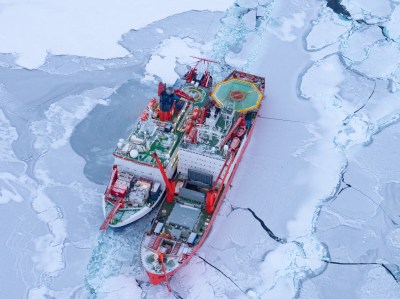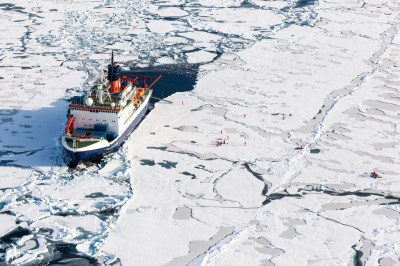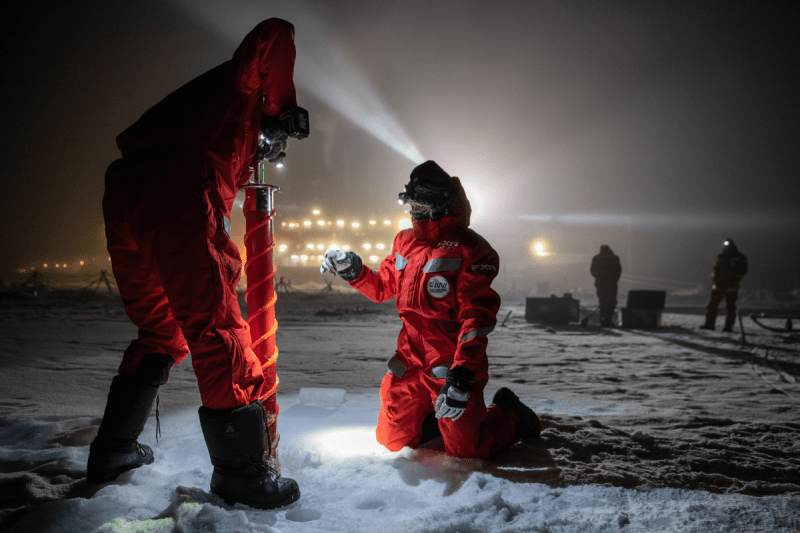Just over a fortnight ago, RV Polarstern, a German research vessel, sailed back into port, heralding the end of the largest Arctic research project ever undertaken. The MOSAiC expedition, short for Multidisciplinary drifting Observatory for the Study of Arctic Climate, spent a full year running experiments to measure conditions at the North Pole, and research how the unique Arctic climate is being affected by human activity.
Unprecedented In Size And Scope

With a budget exceeding €140 million, and with over 300 scientists attached to the project, the expedition aimed to study a full year-long ice cycle in the Arctic region. To achieve this, the research vessel of the project, RV Polarstern, was navigated into an ice floe, and allowed to freeze in and drift with the ice pack. As the seasons progressed, the vessel drifted with the sea ice across the polar region. Along the way, a series of rotating research teams set up equipment on the ice and took regular measurements, investigating several scientific focus areas. Different groups observed atmospheric conditions and the sea ice itself, with researchers also focusing on biogeochemistry, the ocean, and the ecosystems in the area.
Icebreakers were used to transport goods and personnel to the RV Polarstern over the duration of the mission. The project faced issues in spring, as a pre-planned changeover executed by aircraft had to be abandoned due to restrictions brought about by the COVID-19 pandemic. Instead, this was also executed by ship, with the Polarstern temporarily leaving the ice to rendezvous with RV Sonne and RV Maria S. Merian for the changeover of approximately 100 crew and to pick up provisions. The detour took three weeks, but didn’t have any major negative impacts on the mission.
Filling In The Gaps

The MOSAiC expedition’s key goal is to remedy the current uncertainty in climate modelling regarding the Arctic region. This area of the globe has a huge role to play when it comes to climate change, but due to limited data, scientists have found it difficult to accurately project future conditions in the Arctic. By collecting data across a full year, the project’s proponents hope to gain crucial insights into potential future outcomes, as well as to better understand the mechanisms at play in the unique polar environment.
Typically, research teams have been unable to access the central Arctic regions during winter due to the thickness of the ice. By sticking around for the full year and drifting with the ice pack, the researchers were able to get far closer to the North Pole and make continual observations that have until now been impossible. The research teams built a large camp on the ice, with different groups setting up “cities” for their individual specialties. Areas dedicated to robotic underwater explorers, meteorological studies, and ocean measurements each had their own spot on the ice where scientists could work on data collection and investigation.

This was not without its challenges, however. From the very start of the project, warming temperatures meant finding a suitable mass of ice to latch on to was more difficult than expected. As the project progressed, the weaker-than-usual ice routinely cracked and shifted, forcing teams to relocate equipment. However, this also presented a great opportunity to observe up close how ice floes act in present-day conditions.
Other dangers included the very real threat of encountering polar bears. A scanning infrared camera was mounted on the Polarstern, and when polar bears came too close, all personel were brought back on board. On top of this, tripwires with small explosive charges were set around the perimeter of camp to scare bears who ventured too close, and armed guards held watch just in case.
Conclusion

The aim is that with a better understanding of topics like the formation of sea ice, Arctic ocean circulation, and atmospheric conditions at the pole, scientists will be better able to predict the effects of human activity on the world climate. With many open questions around irreversible tipping points in the climate system, this research could prove vital to halting the worst effects of climate change before it’s too late. In pursuit of this goal, the data collected will be shared widely, first with participants in the program, and to the general public starting from 1 January 2023. MOSAiC hopes to produce data that will help generations of scientists unravel the mysteries of how the Arctic climate works.
















I have seen documentary about this with David D. It didn’t end well.
T-3 Alpha Bravo Charlie, cold war era drifting ice islands maintained years of occupancy and science. One of those was a cover article in an old National Geographic I have somewhere. Now we have a longer set of data.
They put out all editions of NatGeo on DVDs years ago, maybe you should look for that.
“This area of the globe has a huge role to play when it comes to climate change, but due to limited data, scientists have found it difficult to accurately project future conditions in the Arctic. ” So, the role might be huge, or huger or not so huge? It all reads like a grant application for a showpiece project. The kind that really piss off the folks who have doing the research for the last 50 years.
I wonder what the ice/snore cores tell them? 45 years ago it was possible to map the artic ice thickness and be able to tell this year’s from last year’s ice and snow. That was with a satellite with microwave radar and SAR and all that. I know. Dirt geologists and ice dynamics people like to get out there with hammers and beakers and balances. But honestly, are there not oil rigs with plenty of space for climate monitoring gear? Oh well, should not comment when tired :-)
Note: I had an office at the Univ. of Puget Sound that was two doors from the USGS Ice Dynamics offices and learned a great deal from those nice researchers.
Yeah, the statement you quoted is a bit confusing, but it is factually correct. We know for certain that the Arctic sea-ice cover is great predictor of what is going on globally with the climate, there are decades of research and data on that. A key piece moving forward is that being able to accurately predict what the cover looks like in the future, lets us know exactly how screwed we are and what, if anything, is working to help reverse climate change. 30 years ago, it was easier to predict what the ice cover would look like a year or two out, but now change is happening so dramatically that we just can’t without a lot more data.